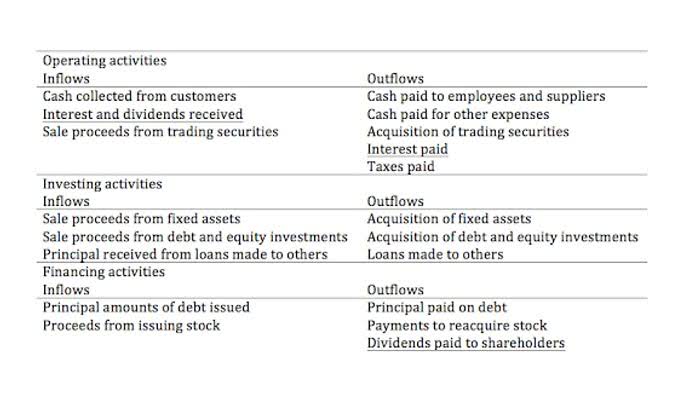
Since liquidity involves cash, you will gain valuable insights by understanding the SCF. Current assets are liquid assets—cash, receivables, and inventory—that can be converted into cash within a year. Businesses draw on current assets to buffer unexpected cash flow volatility and keep the lights on.
Cash is king
There are two types of liquidity – market liquidity and accounting liquidity. Market liquidity refers to the liquidity of a market, such as a stock market or real estate market. It measures the scope for assets to be bought and sold at stable and transparent prices in such a market. Accounting liquidity – which is the focus of this article – measures how quickly a company can pay off its short-term financial obligations using its liquid assets. A current asset is an item on an entity’s balance sheet that is either cash, a cash equivalent, or which can be converted into cash within one year.
Current Asset Presentation in the Balance Sheet
Companies that maintain their assets in an order of liquidity can quickly discern which assets can be tapped at short notice to cover immediate financial needs. For instance, within a balance sheet assets are usually organized in order fixed assets of liquidity. This term refers to the sequence in which assets and liabilities of a company are placed on a balance sheet, from the most liquid to the least.
List of Current Assets
- Companies that maintain their assets in an order of liquidity can quickly discern which assets can be tapped at short notice to cover immediate financial needs.
- As the expenses are used or expire, expense is increased and prepaid expense is decreased.
- Use this designation to list items such as promissory notes, tax refunds, or other liquid holdings that don’t fit into the categories above.
- If the pandemic taught us anything, it is that businesses must always maintain a healthy level of liquidity to be prepared for emergencies and unpredictable challenges.
- Yes, current assets can fluctuate frequently due to changes in sales, inventory levels, and collection of receivables.
Adhering to the standard order of assets from most to least liquid provides consistency and clarity on financial statements. This enables efficient analysis and comparisons for internal and external stakeholders. This includes raw materials, work-in-progress goods, and finished products owned by the company. Bookkeeping vs. Accounting Inventory liquidity varies based on how quickly products sell, but usually within 3-12 months. For example, a company may have the cash immediately on hand but also owe money to creditors in the form of current liabilities. Finally, intangible assets are at the bottom of the list because they are the least liquid and can take longer to convert to cash.
Follow along for a comprehensive overview of the correct order of assets on a balance sheet and why it matters. The order of liquidity can also help creditors assess a company’s creditworthiness. Because they are the most liquid, meaning, you can convert them to cash quickly and easily. For example, a company that relies on inventory would have a different order of liquidity than a company that relies on receivables.
- In essence, having substantially more current assets than liabilities indicates that a business should be able to meet its short-term obligations.
- Unlike liquid assets that can be easily and quickly sold for cash, non-liquid assets or illiquid assets are more difficult to convert into cash.
- The ability to convert assets to cash is called liquidity and it’s measured roughly in units of time.
- The cash ratio is a conservative debt ratio since it only uses cash and cash equivalents.
- This will provide company personnel with more helpful information for managing inventory.

Those liabilities coming due sooner—current liabilities—are listed first on the balance sheet, followed by long-term liabilities. Insurance Expense, Wages Expense, Advertising Expense, Interest Expense are expenses matched with the period of time in the heading of the income statement. Under the accrual basis of accounting, the matching is NOT based on the date that the expenses are paid. They are organized according to the format of the statement of cash flows. The business credit card transactions which are not yet paid must be reported as an accrued liability.

Typically this discussion will reference amounts contained in the corporation’s statement of cash flows. Business people of all backgrounds should become familiar with the statement of cash flows since a company’s liquidity depends on its cash flows. However, in the rare situations when a company’s normal operating cycle is longer than one year, the length of the operating cycle is used in place of one year for determining a current asset. A retailer, distributor or manufacturer may have a large amount of working capital. However, if most of order of liquidity its current assets are in slow-moving inventory, the company may not have the liquidity to pay its obligations on the agreed upon due dates.
Inventory
Therefore, every company needs to be cautious when shipping goods on credit since it could result in a loss of both working capital and liquidity if the company is not paid. The current ratio allows for a comparison between companies of different sizes. However, knowing a company’s current ratio and its amount of working capital is still not enough. It is also important to know when the individual current assets will be turning to cash and when the current liabilities will need to be paid. These examples show how technology can speed up the conversion of a company’s current assets to cash or how the company can delay the payment of cash for some purchases. Both will improve the company’s liquidity without increasing the amount of working capital.
Examples of Current Assets

It’s a helpful method for investors to understand the financial situation of a company and their ability to settle their liabilities. If current assets are low, a company should be able to liquidate non-current assets to settle their liabilities. By defining an account as being liquid, it means that a company can turn the balance of the account into cash relatively quickly. Whether you are a procurement or an accounting professional, understanding current assets and how they can influence financial ratios can be essential to your job.

Technology allows some companies to operate with less working capital than was needed in the past. Take for example a company that sells high demand products on its website with customers paying with credit cards at the time they place an order. The company will receive a bank deposit from the credit card processor within a few days of the sale. It is also possible that the company is allowed to pay its suppliers30 days after receiving the products that will be sold in a few days.
